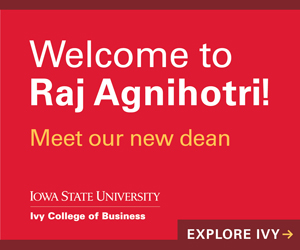Iowans eager for opening of museum they created

Sometimes, it takes a visitor from half a world away to remind Iowans they’ve got something to envy. More specifically, it takes a Queensland, Australia, museum director to say he wants a little of what Iowa has: a sense of ownership in the development of the new $61.9 million Science Center of Iowa that was not to be denied. If he could, Ian Galloway would bottle it and take it back to Australia with him.
The result is a science museum filled with exhibits that plead for participation, Galloway, the director of the Queensland Museum, said after touring the new 110,000-square-foot museum on April 29, two weeks before its May 14 opening.
“It’s lifted interactivity to a new level, and I feel sorry for competing institutions,” he said. “Once people have been so engaged, it’s going to be difficult for other places to measure up. It’s tough competition. I wouldn’t want it opening on my block if I was another museum in town.”
Not that Galloway’s friend, Science Center of Iowa Executive Director Mary Sellers, ever thought about not giving Iowans a say in how the facility would take shape, even if that level of involvement is “unusual for the museum field,” Sellers said.
“We involved the community because that’s what the community expects,” she said. “Look at the level of involvement in the [presidential] caucuses and look at Iowa in general. One of its core values is involvement, and with the experiences we have designed, you have got to actively get engaged. It is intrinsically Iowan and truly reflects who we are as a state.”
Sellers said the approach taken in planning the museum is largely unheard of in the non-profit world, where “a vocal few or a donor take a project down a path it doesn’t want to go.” Instead of offering boilerplate responses when asked about exhibits and other details of the project, she and other Science Center representatives volleyed the questions back to their audiences. Sellers said they told potential donors, “We don’t know the answer, but we’re going to ask the right questions to get the right answers.”
“There were no answers that were forced; we exercised processes to get the right answer,” she said. “If there’s one word that epitomizes this project, it’s process.
“The community truly has formed what we are going to be presenting, and we hope to be more relevant and meaningful and, from a business perspective, more sustainable because we involved the audience we served. That’s common in for-profit ventures, but not so common in the non-profit world.”
Galloway has more than 40 years in the museum field, in positions ranging from scientist to his current post, where he is a key player in Australia’s largest-ever museum development program. His work earned him the Centenary Medal, the Australian government’s highest civilian honor. Yet in his vast experience, he’s never seen anything like what he sees occurring in Iowa: ordinary citizens charting the direction of what he believes is an extraordinary science museum. He calls it “pent-up demand waiting to be realized.”
It’s not uncommon for those leading similar projects to say they want advice from potential museum-goers, “but invariably somewhere along the line, someone opposes that visitor-oriented approach,” Galloway said. “They made sure they asked everyone how they should get there. It wasn’t ‘I know the way, follow me,’ but ‘How can we tap into all the needs and objectives people have, and how can we create a new experience based primarily on that?’”
Galloway and Sellers met at the Getty Institute for Museum Management at the University of California, Berkeley in 1998. They have remained in contact since, and Galloway said he has been spellbound by Sellers’ stories about the unusual approach taken in development of the new Science Center. So when he traveled to the United States for the American Association of Museums annual conference in Indianapolis May 1-5, he fit a trip to Des Moines into his itinerary.
“I wouldn’t have dropped by just out of friendship,” he said. “I’ve been fascinated hearing about [the Science Center’s development]. I don’t think I’ve seen a project that has been so visitor focused and visitor driven.”
The collaborative relationship has been good for both museum directors. While Galloway hopes to duplicate the citizen involvement in the project’s development, Sellers borrows from Galloway’s experiences as the current president of the Australian Committee of the International Council of Museums, a position that has exposed him to the best museum practices worldwide. In terms of relevance to its audience, Galloway predicts the Science Center of Iowa will compete on the world stage.
“It has a real potential to be one of the great science museums in the world,” he said. “Think about the Boston Museum of Science or the Science Museum in London. They’re big institutions with huge budgets, but how they are serving their community and how this one will serve its community is noteworthy internationally.”
Galloway was particularly impressed by the flexibility not only in the design and construction of the building, but also in a financing structure that allows exhibits to be rotated and changed. “Flexibility,” he said, “seems to be its middle name.”
To stretch financial resources and keep exhibits fresh, parts of current exhibits can be used in those planned for the future – through the year 2011, Sellers said.
“These people are all thinking beyond Day 1,” Galloway said of the Science Center staff. “Day 1 is just that – it’s the first day – but they’re thinking years and years into the future.”
Sellers predicts the celebrated 220-seat IMAX Dome Theater may initially lure visitors to the Science Center, but the other exhibits will keep them coming back. She said the idea behind the exhibits isn’t to “define all things science,” but to “ignite a spark” for lifelong learning. “What we’re doing is just being an ignition,” she said.
The IMAX Dome Theater, one of three theaters in the new Science Center, also opens May 14 with “The Living Sea,” a film narrated by Meryl Streep and featuring a soundtrack by Sting. A second show, “Pulse: A STOMP Odyssey,” proves “it’s not your father’s science museum,” Sellers said. That film traces the history of dance in different cultures, showing that rhythm is an international language and offering a skill-building exercise in understanding other cultures.
The new Science Center features a smaller 170-seat theater for large-scale programs and Science Theatre productions and the Star Theater, a one-of-a-kind planetarium designed with help from defense contractor Evans & Sutherland Computer Corp.
The Star Theater is the product of listening to consumers’ – Sellers and the Science Center staff call them “participants” – desire to be able to identify constellations from their own back yards, as well as create a personal planetarium show – something even the highly regarded Adler Planetarium & Astronomy Museum in Chicago hasn’t duplicated. As Sellers explains it, participants will be able to choose from a vast collection of clips of celestial happenings, put them together in a show and then replay them in the Star Theater.
“We’ve done something that has never been done before and others are truly taking our lead on it,” Sellers said.
Galloway thinks the Science Center project makes a positive statement about the intellectual curiosity of Iowans. He was surprised not only by their involvement in the planning, but also by their willingness to support the project financially. So far, $53 million has been raised, and Sellers will announce recent contributions at the May 13 Black Tie Gala the night before the museum opens to the public.
“That spirit of philanthropy doesn’t exist in Australia,” Galloway said. “We have foundations, individuals and organizations that contribute, but what you have is extremely rare. It’s not an in-kind contribution; it’s cash upfront, and that’s just extraordinary, obviously a reflection of the confidence the community has in this project and also the value the community places on this.
“Lots of communities with a 1960s science center would say, ‘Yep, that will do,’” he said. “Stepping into 21st-century science is really important in our lives, and this is a sign of a very confident and forward-thinking community. That is rare.”
Experience this!
After three years of construction, the $61.9 million Science Center of Iowa opens to the public on Saturday, May 14. Located on the new Martin Luther King Jr. Parkway extension between Southwest Third and Fifth streets, the 110,000-square-foot museum is nearly four times the size of the old Science Center in Greenwood/Ashworth Park. Designed to teach participants “how to learn” rather than “what to learn,” the experience platforms include:
– Science is Where You Find It facilitates self-discovery by encouraging participants to recognize science in their everyday lives and see themselves and those around them as everyday scientists. An active space filled with light, movement and sound, it features a familiar home setting where real-life science is done everyday.
– Who Are We? Encourages visitors to explore body and mind through expression, interaction and discovery. Participants fill the role of scientists living in a sophisticated research vehicle in Washington, D.C. One scenario provides the opportunity to investigate the cultures of people from various parts of the country, as well as internationally.
– What on Earth? Takes visitors into a re-created Iowa landscape, beginning at an orientation base camp and continuing through a series of natural environments and field stations where activities build exploration skills. Visitors can choose a playful encounter with the natural world or take one of several expedition challenges to find solutions to a specific tasks through exploration. This learning platform also is the location of the WHO-TV weather studio, where meteorologists will broadcast the weather live from the floor of the Science Center.
– Get Things Moving, the largest experience platform, will explore how things work, fit and move together. Activity clusters encourage participants of all ages to experiment with propellers, robots, air and water tables, and a floor-to-ceiling drop tower, and will connect each activity to real-world science. Also featured is the Iowa Technology Showcase, a display of items related to inventions and new technologies developed in Iowa, and the Current Science and Technology Stage, a live demonstration arena focusing on current news or events in science and where visitors can discover news and trends in science via computer software.
– Why the Sky? Taps the imagination of participants as they explore the cosmos and our place in it. The opening experience, Imagine Living With a Star, explores what we have traditionally seen or thought about the sun and is complemented by experiences that let visitors imagine what outer space is like and what it might be like to explore space. Why the Sky? is adjacent to the Star Theater, a walk-through planetarium with eight operating modes.
– Small Discoveries is specifically designed for families with children under the age of 7. Building early learning skills for asking and answering questions, age-appropriate discovery challenges create a realistic, welcoming, comfortable, safe and stimulating environment. Focused play and Iowa-themed activities offer opportunities for interaction with other children. Parents play a major role, actively assisting their children and discovering what kinds of skills are strengthened through different activities.
– The Changing Exhibitions Platform features large-scale blockbuster exhibits from around the country and offers hands-on activities to complement and enhance the overall Science Center experience. The area will be fully programmable and capable of using sound, light and multimedia functions and movable walls to create an ever-changing space capable of hosting a variety of exhibits.
– The Science Center also features the IMAX Dome Theater, the first IMAX theater in Central Iowa and the most advanced in the state, as well as two other theaters. The Star Theater, a 50-foot domed theater with eight operating modes, can be used for live programs about the night sky in Iowa or to take visitors on a journey through the cosmos that they created themselves. The John Deere Adventure Theater, a 175-seat multipurpose theater with state-of-the-art technology functions, will host large-scale demonstrations, live performances and symposiums on science and technology.
The institution’s commitment to learning is demonstrated at the Iowa Learning Center, the Science Center’s preschool, as well as a teacher resource center, cyber laboratories for extended interactive experimentation, and a commons area for school and group orientations and briefings. Distance learning and outreach programs will also originate from the Iowa Learning Center.
The museum also features a restaurant and gift shop.







